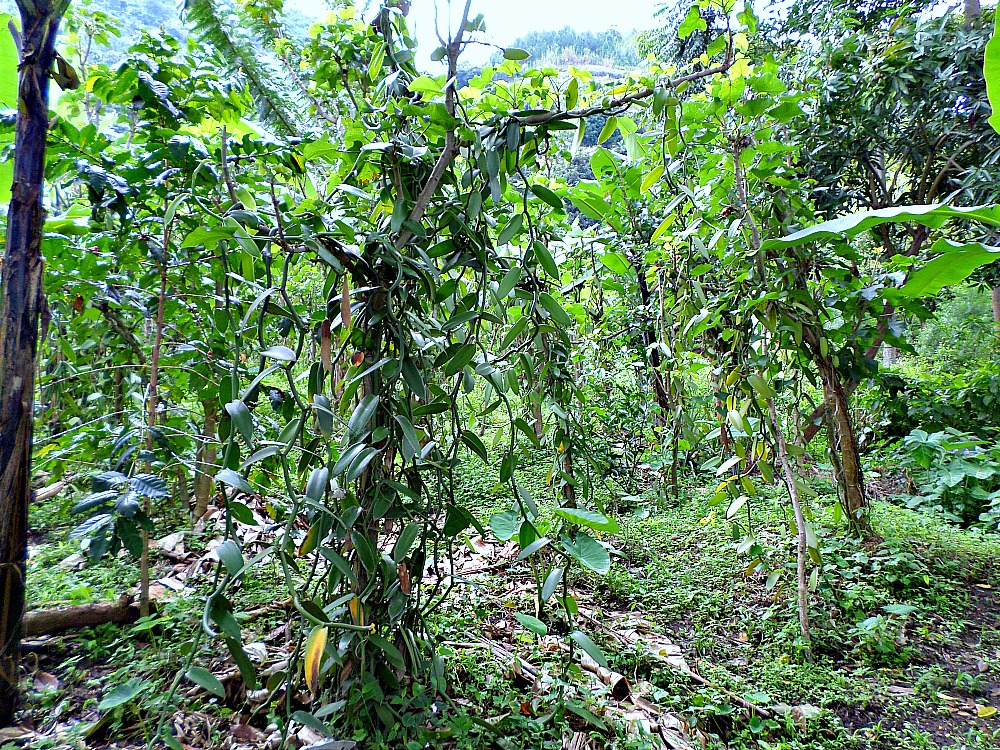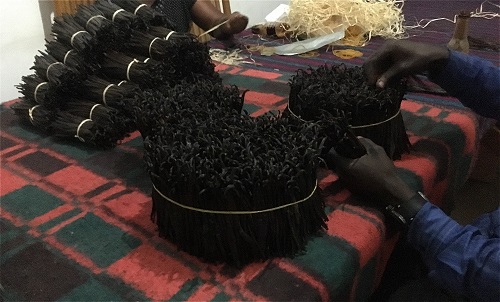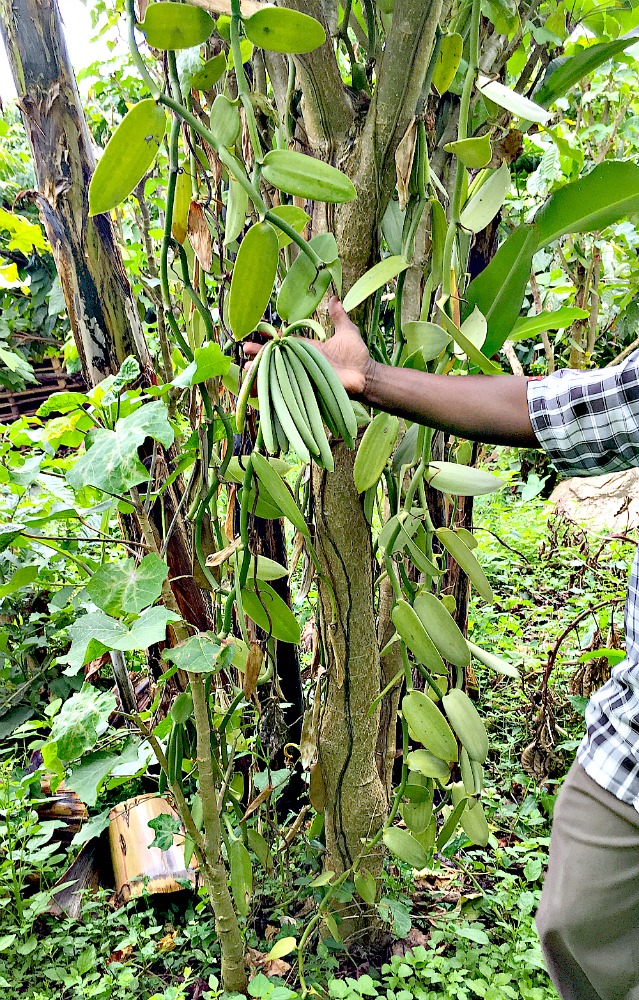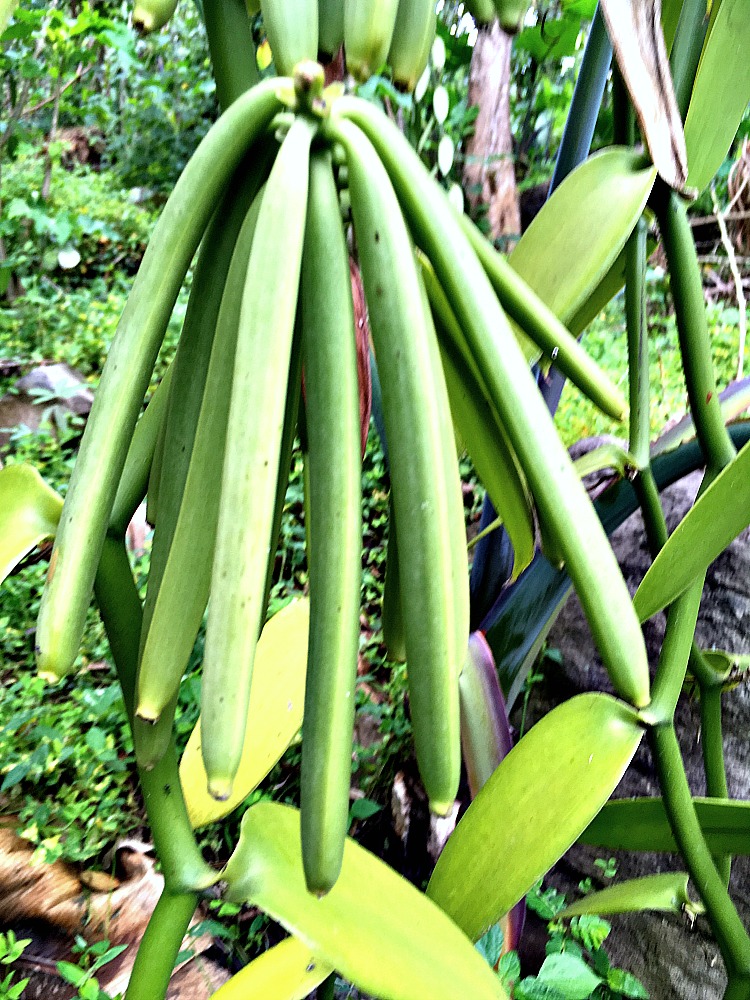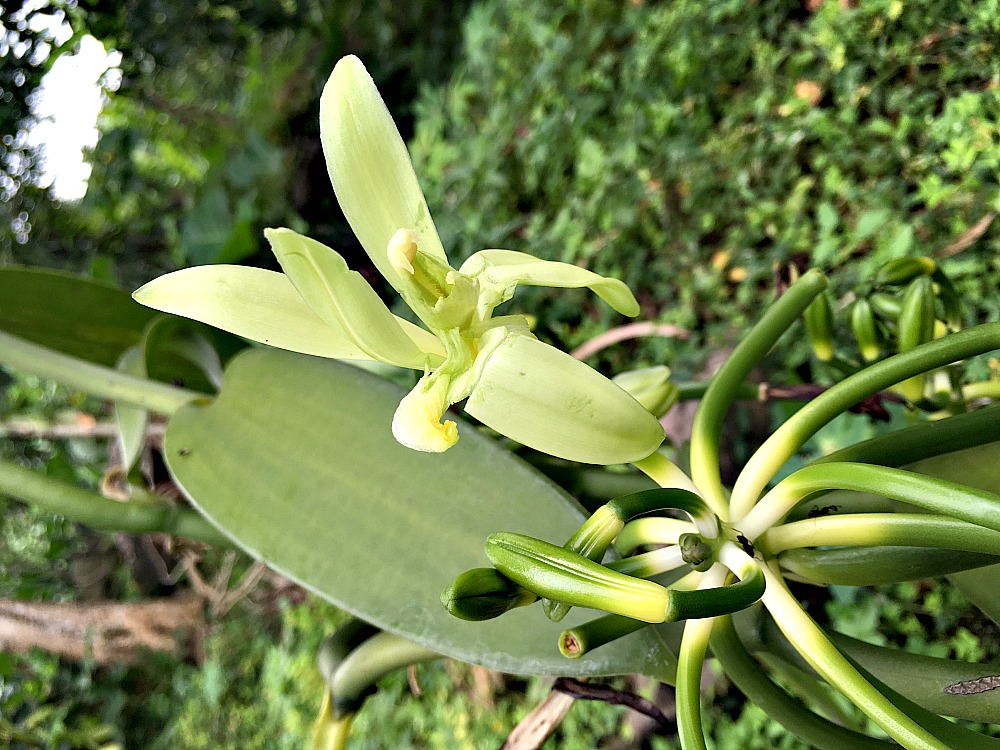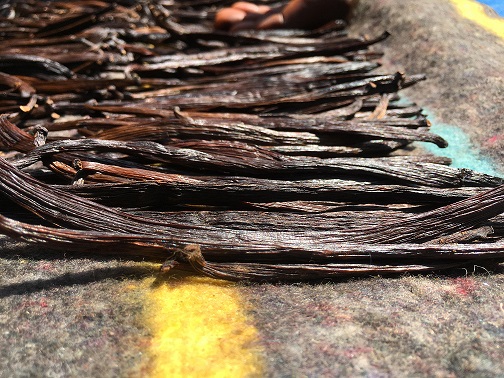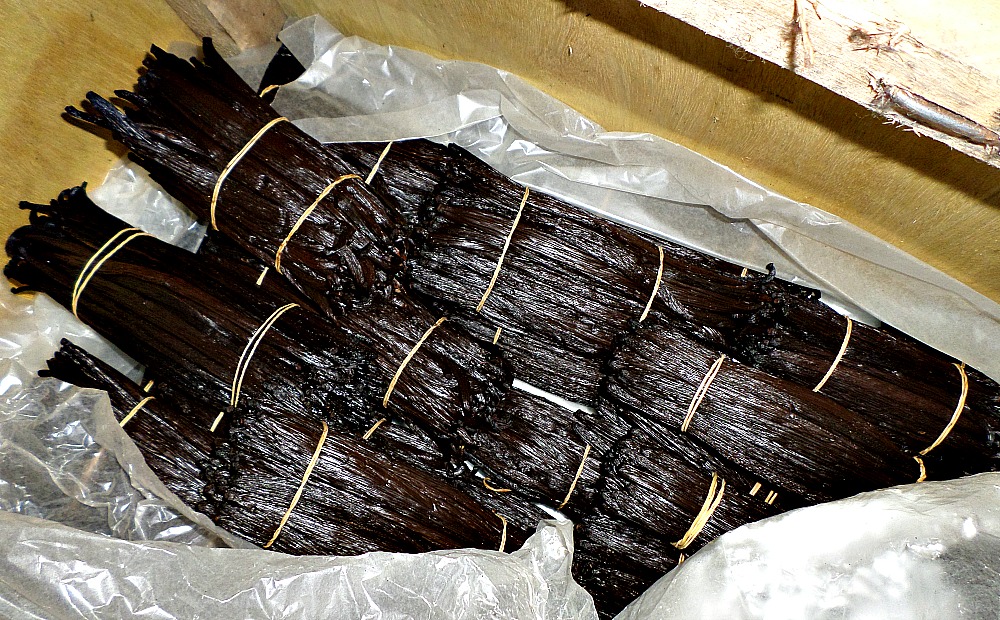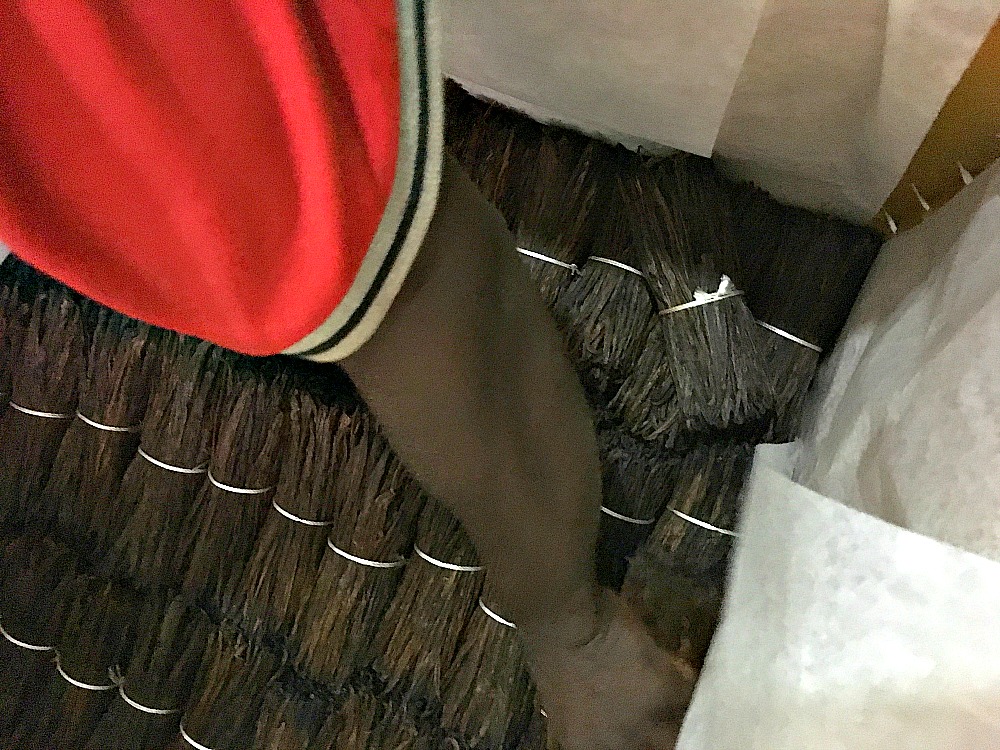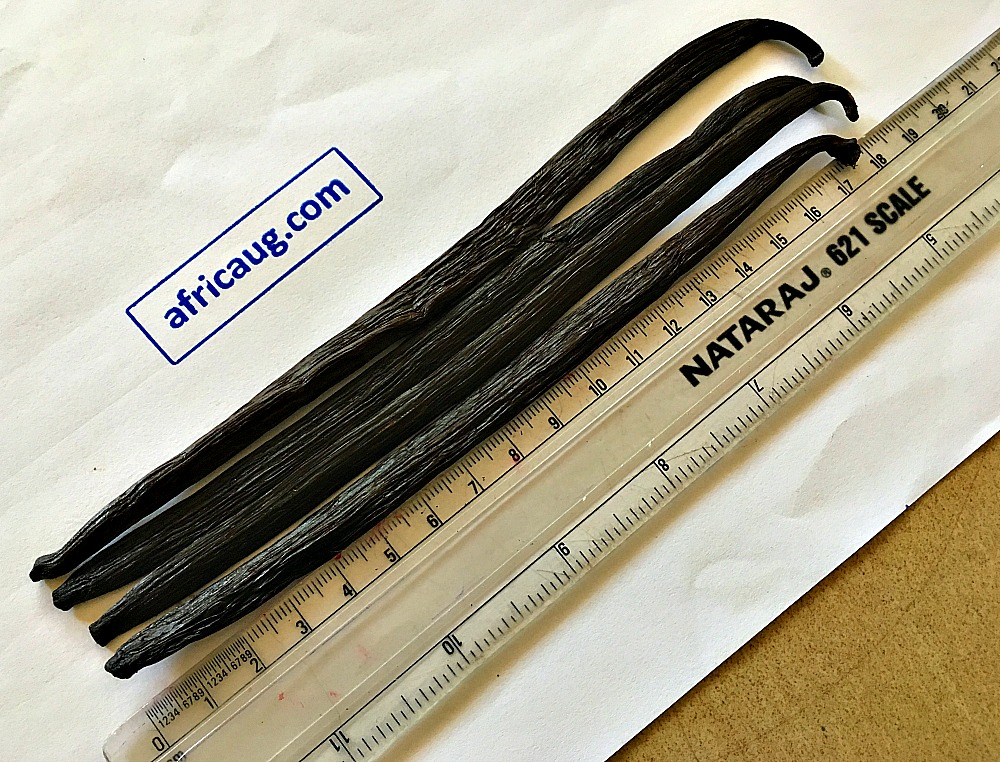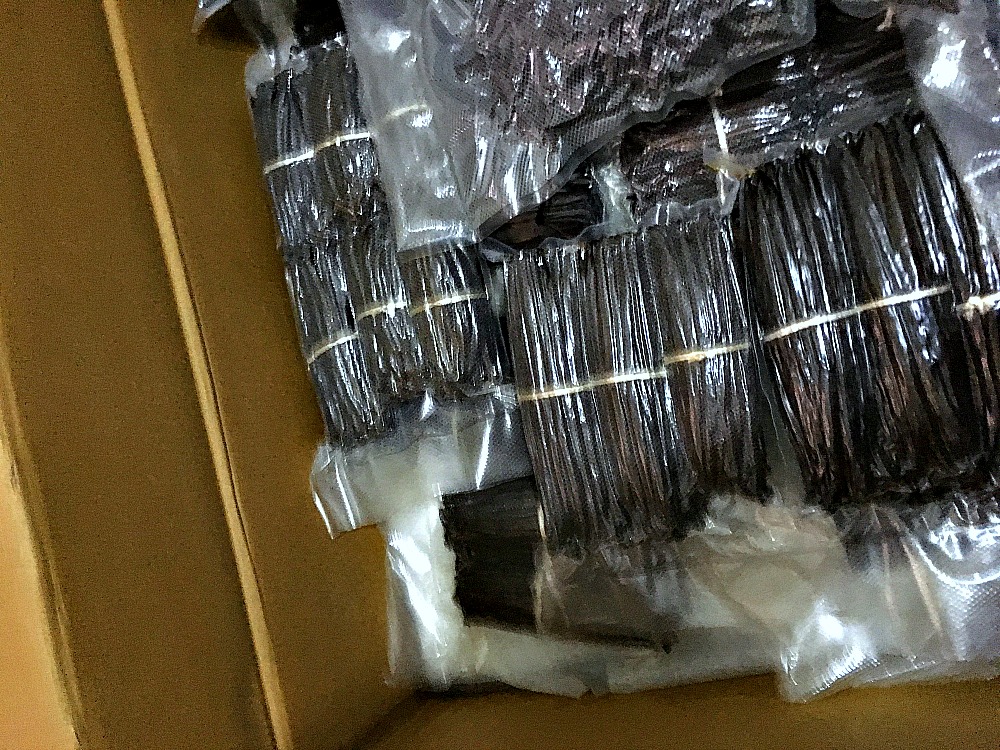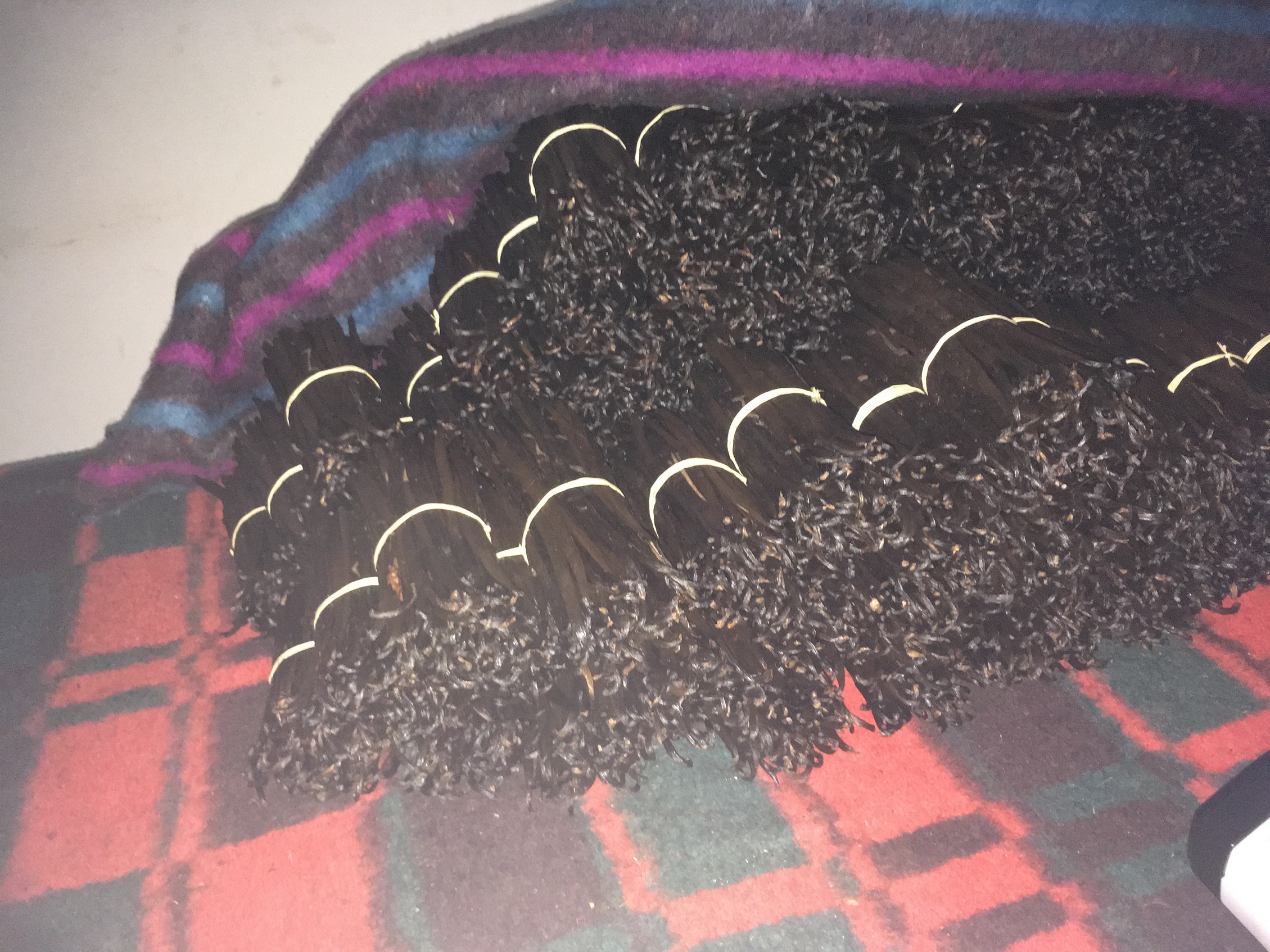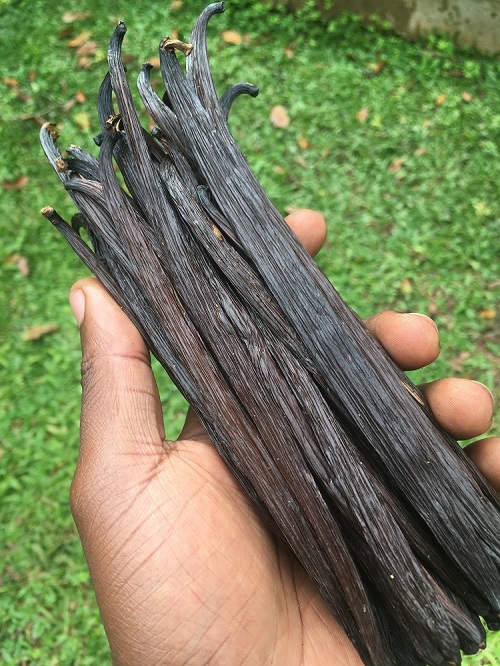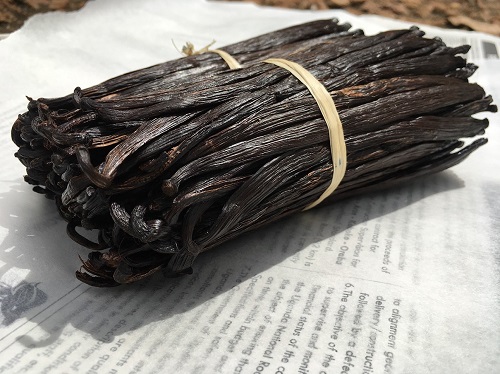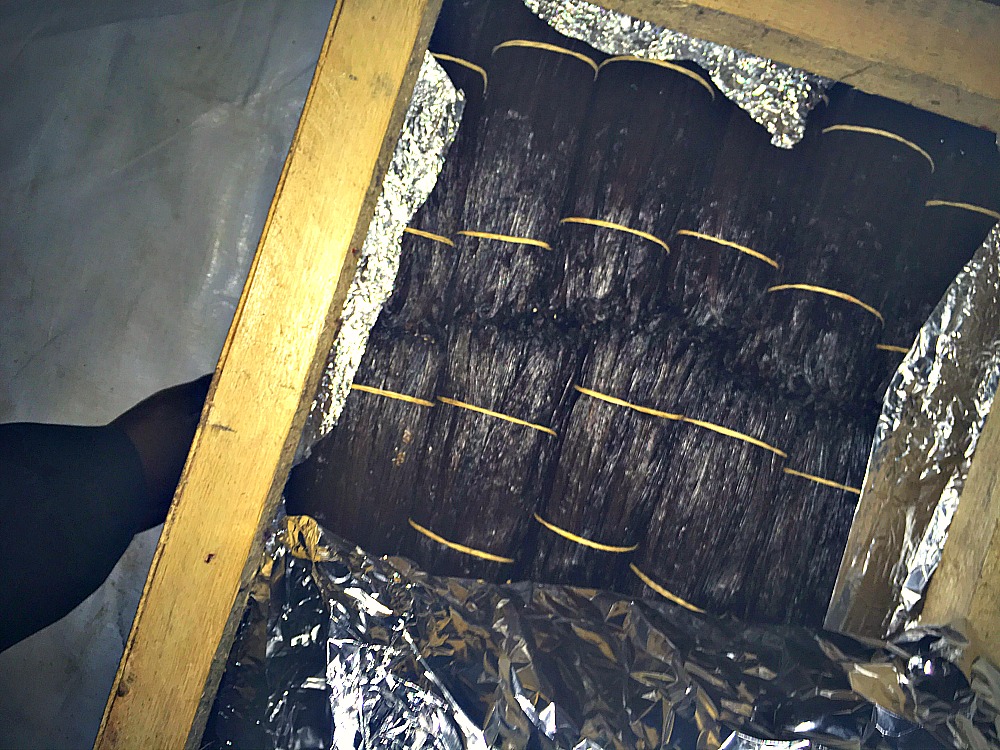How to grow COCOA in Uganda
All chocolate begins with cocoa beans, the fruit of a perennial cocoa tree.
Scientist say the tree originated somewhere in south or Central America.
Some say the first trees grew in the Amazon basin of Brazil while others place its origin in the Orinoco valley of Venezuela.
Wherever it’s first home, we know the cocoa tree is strictly a tropical plant thriving only in hot, rainy climates.
This places Africa as a main home for cocoa growth.
Cocoa can only be cultivated within 20 degrees north and south of the equator.
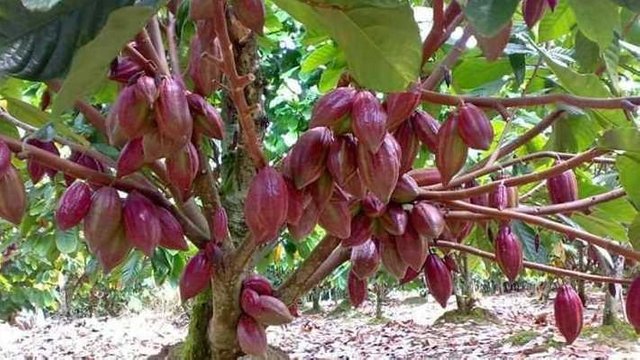
Common Cocoa varieties in Africa
There are two main species of cocoa, criollo and forastero.
Criollo is sometimes called the price of cocoas as it’s a very high quality grade of cocoa with exceptional flavor and aroma.
A third type of cocoa is Trinitario hybrid or across between the main species.
How to Propagate Cocoa in Uganda
Cocoa is propagated both by seed and by cuttings.
Seeds are planted at stake where 3 seeds are planted per hole and later thinned to one.
Germination often is complete within 15 days of seed planting.
Alternatively cuttings can be obtained from young vigorous healthy trees in the mother garden.
These should be cut at a right angle usually above anode 5-12 inch along with 3-9 leaves.
Remove the bottom leaves and dip the base in a rooting hormone.
How to Plant Cocoa
Traditionally cocoa grows under a shade, such as natural shades provided by other trees.
So in preparation of the land for planting you should pick land which will protect the cocoa from direct sun light and winds.
The size of the hole should be at least 2ft X 2ft
The size of the hole should be at least 2ft X 2ft
Transplant of the seedlings when steady rains set in before the dry season.
A spacing of 3mx3m should be used which gives a plantation of 1000 trees per hectare.
REPLACING MISSING SEEDLINGS
Sometimes certain cocoa seedlings do not grow well. They remain small or die.
During the months following the day when you planted your seedlings, you must always look to see whether the cocoa trees are growing well.
If you see diseased or dead cocoa trees, pull them out and burn them, and also those encircling them in case of swollen shoot disease . In their place, plant other young cocoa seedlings, from among those that you have kept in the nursery bed or in baskets.
If you see diseased or dead cocoa trees, pull them out and burn them, and also those encircling them in case of swollen shoot disease . In their place, plant other young cocoa seedlings, from among those that you have kept in the nursery bed or in baskets.
Crops that can be intercropped with Cocoa
When cocoa has just been planted, it provides enough space that make it convenient for other crops to grown as well. Cocoa like any other tree plant, requires a lot of nitrogen for vegetative growth. It is therefore advisable that intercropping cocoa with legumes is a well thought idea. The legumes are known to be excellent nitrogen fixers which makes cocoa growth and establishment vigorous.
On a commercial basis and profitability, it is commercially wise to intercrop the plant with banana for the following reasons.
Remember, our primary goal for intercropping cocoa is ti increase profitability. Nothing more
- The fact that bananas start producing in not more than a year, they will be in position to provide food to the farmer and if sold to the markets, they provide capital which can be used to manage the cocoa plants through be able to pay for laborers, buy fertilizers and manure where necessary . By this, the farmer does not feel the burden of rising the funds to look after the plantation from other sources
 |
| Young cocoa trees intercropped with mature banana plants. Such a practice is good more especially if cocoa is your primary target crop and your using bananas as shade crops |
- The bananas provide shade to cocoa as it grows. Cocoa like coffee, highly need shade especially when still young and during the maturity period when they have started fruiting. If not provided with shade during those stages, the chances of reaching economic loss if high. It is therefore advisable that you intercrop your cocoa field with some bananas to provide shade.
Apart from legumes and banana, you can do what we can enterprise mix, where legumes, banana and cocoa can be on the same piece of land but you have to be mindful of the spacing for the banana as this time, it increases from 3M to 6M. This increases the intensity of light received by the legumes and also provides a better atmosphere in your field.
 |
| Cocoa plants intercropped with coffee and bananas |
The same enterprise mix can be done where you can decide to mix cocoa, banana and coffee. However, when you do this mix, you need to determine which of the three ( cocoa, banana and coffee) do you take as your primary enterprise. If for example it is cocoa for this matter, the the spacing for the other two has to be double to provide enough growing space to the cocoa plant.
Remember, cocoa, banana and coffee need the same spacing (10ftX10ft) and this translates to 450 plants of each in an acre and about 1000 in an hectare. But the fact that we primarily want cocoa as our major crop, then we have to increase the spacing for the other two to 20ft x 20ft. This means we shall half the amount of each ( 225). Coation has to be taken not to make your plantation a mess by over populating these three crops in the name of enterprise mix.
Do not worry about this, if you fill you have not understood it where, please contact us, we will be able to guide you


How to Weed Cocoa in Uganda
Weeding cocoa field is as easy as weeding any other plant. However, the tools to be used during cocoa weeding are highly determined by the level of maturity of your cocoa field
- For young field that are not more one year, our ordinary hand hoes can be used. Because at this time, the root network is not well established and pronounced. But even then, avoid digging around the plant to avoid damaging the cocoa roots.
- For a mature plantation, use of hand hoes must be totally avoided. At this level, we all know the roots have fully established and if they are damaged in any way, then plant growth will be retarded and this affects the yield and most particularly the pod size reduce.
- Weed 3 to 4 times a year. This should be done by ring weeding around the cocoa trees and slashing along the rows of the cocoa trees. This should be done using forked hoes to avoid damaging the roots
Application of manure and fertilizers
Cocoa like any other coffee and bananas is a heavy feeder crop. This literally mean that it requires a lot of nutrient.Application of nutrients depending on the stage and level of growth of the cocoa plant. This is so because the rate of nutrient requirement depends on the stage of the plant growth. And the only way to do this is through addition of nutrients through manure and fertilizer application. The major nutrients elements required are Phosphorus during planting - for root establishment. This is obtained by addition of organic manure during planting at a ratio of 1:2. And in case of inadequate manure, fertilizers can also provide the necessary nutrient. Let us look at it in this angle
- During planting, the cocoa plant needs a lot of phosphorus (P) and this can be obtained through use of organic manure as we saw earlier on. At this stage, we are only looking at how best the cocoa plant will establish quickly given the dynamics in the growth conditions. The application of manure therefore provides the necessary nutrients need for crop establishment. Organic manure is believed to the only form of nutrient source that provide almost all the required growth elements to plants.The only limiting factor is that it is hard to get enough for the entire plantation. This is where farmers are advised to complement the application through the inorganic fertilizers. However, caution must be taken on what to buy at what stage. We shall have a detailed analysis of fertilizer usage and rates at a later date but let us get the basics for this case. Since we need a lot of P during crop establishment, you are therefore advised to buy fertilizer specific for this this element ( a phosphate fertilizer for this matter). They are many of them in the market like DAP, MOP, SSP, TSP and others but since we saw that cocoa is among the heavy feeder crops, this means that every nutrient must be provided in abundance and in this, TSP is believed to have a lot of P compared to the other (Tri Super phosphate). So during planting, apply at least a palmful of TSP to each cocoa plant. This should be mixed in the used which is replaced back into the hole during filling. Using NPK is also advisable but the percentage of P must be higher than the other two ( at least 46%P) or NPK flat
- When the plant has established, it now needs a lot of Nitrogen to encourage the attraction of more sun light and also be able to make its food.Just make a ring around the plant of about 1ft and apply the nitrogen fertilizer. CAN, urea or any other nitrogen fertilizer can be used at a rate of 250g
- The same can be done to the potassium fertilizer. This must be applied when our cocoa plant is just a few months to fruiting. K is a good element that encourages and enhances fruiting among the growing crops like cocoa.
- Please note that the rates of application of these nutrient elements increases as the plants grows. In shorts, the rates used to feed a young cocoa plant are not the same when the cocoa plants reach one or more years. The rates increase with increasing maturity of the the cocoa plant.
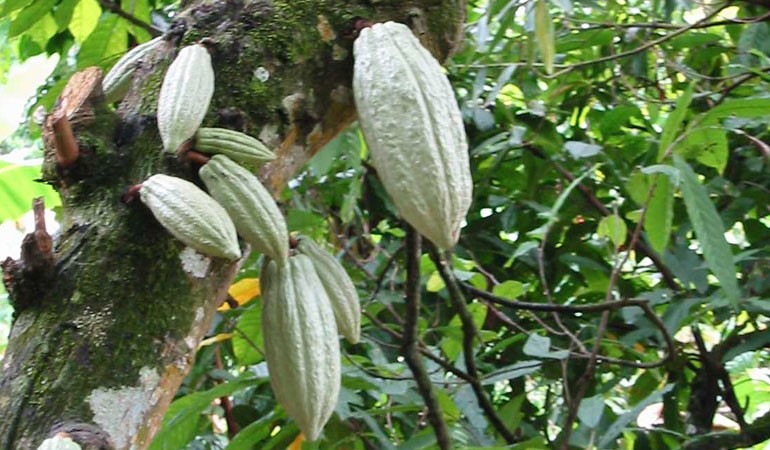
| Ring fertilizer application |
Pruning of the cocoa plant
The cocoa tree is a tree that develops well.
It has a single, straight trunk.
A crown of 3 to 5 main branches forms about 1.5 metres above ground level.
Sometimes, during the first year, several shoots form on the trunk.
Cut off these shoots and leave only the strongest.
Sometimes the crown forms too low down, at less than 1 metre above ground level.
Choose a shoot which grows straight up and let it develop.
A new crown will then form at a good height, and the first crown will stop growing.
Cut off these shoots and leave only the strongest.
Sometimes the crown forms too low down, at less than 1 metre above ground level.
Choose a shoot which grows straight up and let it develop.
A new crown will then form at a good height, and the first crown will stop growing.
| Young well-grown cocoa tree | |
| Young cocoa tree with two shoots | Cocoa tree which forms its crown too low down |
Always cut out all dead branches, dry twigs and suckers.
A sucker is a twig that grows upward out of the trunk.
Cut off the suckers very close to the trunk.
Cut off the suckers very close to the trunk.
When a cocoa tree gets old, it no longer yields many pods.
But you can make cocoa trees young again by letting one or two suckers grow low down on the trunk where they can develop their own roots.
Then cut down the old trunk, and you will again have a cocoa tree that yields many pods.
But you can make cocoa trees young again by letting one or two suckers grow low down on the trunk where they can develop their own roots.
Then cut down the old trunk, and you will again have a cocoa tree that yields many pods.
Pests and diseases that affect the cocoa plant
There are various diseases and pests that attack the cocoa plant and these are listed below:
Cocoa swollen shoot
This is caused by a virus and it leads to the swelling of the shoots and leaves. It leads to defoliation of the leaves causes stem swelling and the growth of nodes on the shoots of the leaves.
It can prevented and managed by separating the cocoa plants with a 33 feet distance and the affected area should be cut off to prevent further spread of the disease to other parts.
The cocoa pod borer
This affects the cocoa by the insect larvae entering into the pods before they mature. These make it extremely difficult to separate the beans from the pods and it can be prevented by placing the pods in plastic bags to prevent the insects from laying their lava on the immature pods.
The witch’s broom
It is caused by fungi and its symptoms include branches that do not produce fruit, discolored leaves and pods which have uneven ripening and green patches.
The infected area should be cut off and discarded whereas the cocoa should be planted in a clean environment as this will reduce on the spread of disease.
The frosty pod disease
This is caused by fungi and it causes the cocoa to have spots on the pods which are brown in color and it should be noted that they mostly affect growing pods.
The application of copper and cutting down the affected area can prevent the spread of the diseases and if possible, the cocoa should be planted in the dry season.
Challenges faced in cocoa growing
The climatic change in Uganda is a bit of challenge to the farmers in the country. This can cause immature growth of the cocoa pods leading to losses on the farm.
There is also a problem of pests and diseases that attack the cocoa causing poor yields during harvesting period.
Most of the farmers are not aware of the market for cocoa and they end up selling the cocoa for less than what it is supposed to be sold for making loses in the process.
Cocoa has an increase in demand and this has become a problem because the cocoa produced does not meet the required demand.
Benefits of growing cocoa in Uganda
-
It provides employment opportunities to the people through labor and the farmer also earns big from the cocoa.
-
Cocoa helps health wise in controlling heart attacks in people.
-
Cocoa husks can b used as manure for gardens which improves the fertility of the soils.
-
Cocoa is also a form of food in form of chocolates which are eaten by everyone after processing it.
With the ever changing world and market all around, we all need to move with the changing world and cocoa is becoming a fast trending crop in the country. Therefore for those that want to earn a bit more and gain from the crop both through imports and exports, try growing cocoa and you will not regret it.
How to Harvest Cocoa
It provides employment opportunities to the people through labor and the farmer also earns big from the cocoa.
Cocoa helps health wise in controlling heart attacks in people.
Cocoa husks can b used as manure for gardens which improves the fertility of the soils.
Cocoa is also a form of food in form of chocolates which are eaten by everyone after processing it.
Harvesting Cocoa involves removing ripe pods from the tree, and opening them to extract the wet beans.
Ripe pods assume a distinctive color and seeds rattle inside, green pods turn yellow and red pods turn orange.
Make a clean cut through the stalk with a well sharpened blade to remove the cocoa seeds.
PROCESSING COCOA BEANS
Opening the pods.
Do not wait more than 4 days to open the pods.
Open the pods by hitting them with a thick piece of wood.
Take the beans out of the pods and put them in baskets.
Then carry them to the place where they are to ferment.
Do not leave the broken husks on the field.
They can be used to make compost.
Why cocoa beans are fermented.
Do not wait more than 4 days to open the pods.
Open the pods by hitting them with a thick piece of wood.
Take the beans out of the pods and put them in baskets.
Then carry them to the place where they are to ferment.
Do not leave the broken husks on the field.
They can be used to make compost.
Why cocoa beans are fermented.
| Longitudinal section of a cocoa plant |
We have seen that the cocoa bean consists of a seed coat, a kernel and a germ.
Cocoa beans are fermented so as to destroy the seed coat, kill the germ and give the cocoa a good taste.
Cocoa beans are fermented so as to destroy the seed coat, kill the germ and give the cocoa a good taste.
| Good fermentation box |
Often cocoa growers ferment the beans in heaps. They chose a flat and dry spot, cover it with banana leaves, make a heap of cocoa beans and cover the heap with banana leaves.
The beans ferment well if the heap is stirred from time to time.
It is much better to ferment the beans in boxes.
Use boxes with holes in the bottom.
Place these boxes on supports, for instance stones.
The juice runs off at the bottom of the boxes through the holes.
After two days, take the beans out of the box, stir them around well and put them into another box.
To make this work easier, you can stack the boxes one on top of the other.
Never leave the beans in the same box for more than two days.
Fermentation takes 6 to 10 days.
The beans are purple at the beginning, and turn reddish when they are fermented.
Drying cocoa beans
When the beans are well fermented, they must be dried.
The beans ferment well if the heap is stirred from time to time.
It is much better to ferment the beans in boxes.
Use boxes with holes in the bottom.
Place these boxes on supports, for instance stones.
The juice runs off at the bottom of the boxes through the holes.
After two days, take the beans out of the box, stir them around well and put them into another box.
To make this work easier, you can stack the boxes one on top of the other.
Never leave the beans in the same box for more than two days.
Fermentation takes 6 to 10 days.
The beans are purple at the beginning, and turn reddish when they are fermented.
Drying cocoa beans
When the beans are well fermented, they must be dried.
Cocoa beans may be dried in the sun.
Spread the beans on boards raised 1 metre above ground level.
The layer of beans should not be very thick; not more than 4 centimetres.
Stir the beans often and protect them from rain.
To protect from rain, you can make a little shelter and slide the boards under the shelter every night and when it rains:
This is called a sliding tray drier.
Drying cocoa beans takes five to ten days.
In forest regions where the climate is very moist, cocoa beans do not dry at all well.
Badly dried beans are of poor quality.
You get less money for them.
In such regions several growers can get together and build a modern drier.
Spread the beans on a concrete slab set well above floor level.
Light a fire underneath, or allow hot air to pass through drums to heat the concrete slab.
Then the cocoa beans will dry better.
In this way one man alone can take care of drying the harvest of several growers.
He should not let the fire get too hot, to prevent the beans from becoming smoky.
He should stir them often so that they do not burn.
When the cocoa is quite dry, the beans are sorted.
Spread the beans on boards raised 1 metre above ground level.
The layer of beans should not be very thick; not more than 4 centimetres.
Stir the beans often and protect them from rain.
To protect from rain, you can make a little shelter and slide the boards under the shelter every night and when it rains:
This is called a sliding tray drier.
Drying cocoa beans takes five to ten days.
In forest regions where the climate is very moist, cocoa beans do not dry at all well.
Badly dried beans are of poor quality.
You get less money for them.
In such regions several growers can get together and build a modern drier.
Spread the beans on a concrete slab set well above floor level.
Light a fire underneath, or allow hot air to pass through drums to heat the concrete slab.
Then the cocoa beans will dry better.
In this way one man alone can take care of drying the harvest of several growers.
He should not let the fire get too hot, to prevent the beans from becoming smoky.
He should stir them often so that they do not burn.
When the cocoa is quite dry, the beans are sorted.
- Remove all the:
- flat beans
- germinated beans
- mouldy beans
- broken beans.
- Keep only good beans.
- Put these good beans into sacks.
- Keep the sacks in a dry place well protected against animals.
- Finally sell your sacks of cocoa.
- well harvested,
- well fermented,
- well dried.
Sliding tray drier
Quick Tips for growing cocoa in Africa
- Open up hole in arrow with a spacing of 3mx3m
- Harden off seedlings meant for planting, by gradually increasing light and reducing humidity. This takes 28days.
- Transfer the hardened off seedlings into the field, ensure to remove the polythen leaving the seedling with a ball of earth
- Put it in a hole and cover firmly with top soil first then subsoil.
- Water thinly and mulch to conserve the soil moisture. However a small space of 5-6cm around the seedlings base should be left clear to allow air circulation.
- Weed the plants basing on the intensity of the weeds
- Prune the tree leaving only one main stem to facilitate formation of a cone canopy.
- Apply sufficient fertilizers where necessary
- Harvest the pods when they ripen off







